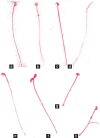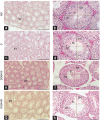Glutathione (GSH) improves sperm quality and testicular morphology in streptozotocin-induced diabetic mice
- PMID: 33473013
- PMCID: PMC8152417
- DOI: 10.4103/aja.aja_81_20
Glutathione (GSH) improves sperm quality and testicular morphology in streptozotocin-induced diabetic mice
Abstract
Diabetes mellitus (DM) is known to cause reproductive impairment. In men, it has been linked to altered sperm quality and testicular damage. Oxidative stress (OS) plays a pivotal role in the development of DM complications. Glutathione (GSH) is a part of a nonenzymatic antioxidant defense system that protects lipid, protein, and nucleic acids from oxidative damage. However, the protective effects of exogenous GSH on the male reproductive system have not been comprehensively examined. This study determined the impact of GSH supplementation in ameliorating the adverse effect of type 1 DM on sperm quality and the seminiferous tubules of diabetic C57BL/6NTac mice. GSH at the doses of 15 mg kg-1 and 30 mg kg-1 was given intraperitoneally to mice weekly for 6 consecutive weeks. The mice were then weighed, euthanized, and had their reproductive organs excised. The diabetic (D Group) showed significant impairment of sperm quality and testicular histology compared with the nondiabetic (ND Group). Diameters of the seminiferous lumen in diabetic mice treated with 15 mg kg-1 GSH (DGSH15) were decreased compared with the D Group. Sperm motility was also significantly increased in the DGSH15 Group. Improvement in testicular morphology might be an early indication of the protective roles played by the exogenous GSH in protecting sperm quality from effects of untreated type 1 DM or diabetic complications. Further investigation using different doses and different routes of GSH is necessary to confirm this suggestion.
Keywords: diabetes mellitus; glutathione; mice; sperm quality; testis histology.
Conflict of interest statement
None
Figures





Similar articles
-
Ameliorative effect of hesperidin on streptozotocin-diabetes mellitus-induced testicular DNA damage and sperm quality degradation in Sprague-Dawley rats.J Food Biochem. 2021 Oct;45(10):e13938. doi: 10.1111/jfbc.13938. Epub 2021 Sep 16. J Food Biochem. 2021. PMID: 34532874
-
Diosgenin ameliorates testicular damage in streptozotocin-diabetic rats through attenuation of apoptosis, oxidative stress, and inflammation.Int Immunopharmacol. 2019 May;70:37-46. doi: 10.1016/j.intimp.2019.01.047. Epub 2019 Feb 19. Int Immunopharmacol. 2019. PMID: 30785089
-
Effect of spermidine on ameliorating spermatogenic disorders in diabetic mice via regulating glycolysis pathway.Reprod Biol Endocrinol. 2022 Mar 7;20(1):45. doi: 10.1186/s12958-022-00890-w. Reprod Biol Endocrinol. 2022. PMID: 35255928 Free PMC article.
-
Protective effects of nanostructures of hydrated C(60) fullerene on reproductive function in streptozotocin-diabetic male rats.Toxicology. 2011 Apr 11;282(3):69-81. doi: 10.1016/j.tox.2010.12.003. Epub 2010 Dec 14. Toxicology. 2011. PMID: 21163323
-
Diabetes and the impairment of reproductive function: possible role of mitochondria and reactive oxygen species.Curr Diabetes Rev. 2008 Feb;4(1):46-54. doi: 10.2174/157339908783502398. Curr Diabetes Rev. 2008. PMID: 18220695 Review.
Cited by
-
Melatonin as a potential adjuvant to mitigate depakine‑induced testicular damage in rats through its biological features.BMC Complement Med Ther. 2025 Jun 25;25(1):213. doi: 10.1186/s12906-025-04969-w. BMC Complement Med Ther. 2025. PMID: 40563113 Free PMC article.
-
Role of Redox-Induced Protein Modifications in Spermatozoa in Health and Disease.Antioxidants (Basel). 2025 Jun 12;14(6):720. doi: 10.3390/antiox14060720. Antioxidants (Basel). 2025. PMID: 40563353 Free PMC article. Review.
-
Nicotinamide mononucleotide improves spermatogenic function in streptozotocin-induced diabetic mice via modulating the glycolysis pathway.Acta Biochim Biophys Sin (Shanghai). 2022 Aug 25;54(9):1314-1324. doi: 10.3724/abbs.2022099. Acta Biochim Biophys Sin (Shanghai). 2022. PMID: 35929593 Free PMC article.
-
The Potential Effect of Bualuang (White Nelumbo nucifera Gaertn.) Extract on Sperm Quality and Metabolomic Profiles in Mancozeb-Induced Oxidative Stress in Male Rats.Life (Basel). 2024 Dec 24;15(1):6. doi: 10.3390/life15010006. Life (Basel). 2024. PMID: 39859946 Free PMC article.
-
Protective effects of lupeol on pesticides induced testicular and oxidative damage of male rats.J Mol Histol. 2025 May 8;56(3):151. doi: 10.1007/s10735-025-10425-3. J Mol Histol. 2025. PMID: 40341998 Free PMC article.
References
-
- Institute for Public Health (IPH), National Institutes of Health, Ministry of Health Malaysia. National Health and Morbidity Survey (NHMS) 2019: Vol.I: NCDs-Non-Communicable Diseases: Risk Factors and Other Health Problems. Selangor: Ministry of Health Malaysia; 2020. pp. 26–67.
-
- Agbaje I, Rogers DA, McVicar CM, McClure N, Atkinson AB, et al. Insulin dependant diabetes mellitus: implications for male reproductive function. Hum Reprod. 2007;22:1871–7. - PubMed
-
- Guariguata L, Whiting DR, Hambleton I, Beagley J, Linnenkamp U, et al. Global estimates of diabetes prevalence for 2013 and projections for 2035. Diabetes Res Clin Pract. 2014;103:137–49. - PubMed
-
- Maresch CC, Stute DC, Ludlow H, Hammes HP, de Kretser DM, et al. Hyperglycemia is associated with reduced testicular function and activin dysregulation in the Ins2Akita+/− mouse model of type 1 diabetes. Mol Cell Endocrinol. 2017;446:91–101. - PubMed
-
- World Health Organization. World Health Statistics 2016: Monitoring Health for the SDGs Sustainable Development Goals. Geneva: World Health Organization; 2016.
Publication types
MeSH terms
Substances
LinkOut - more resources
Full Text Sources
Other Literature Sources
Medical

